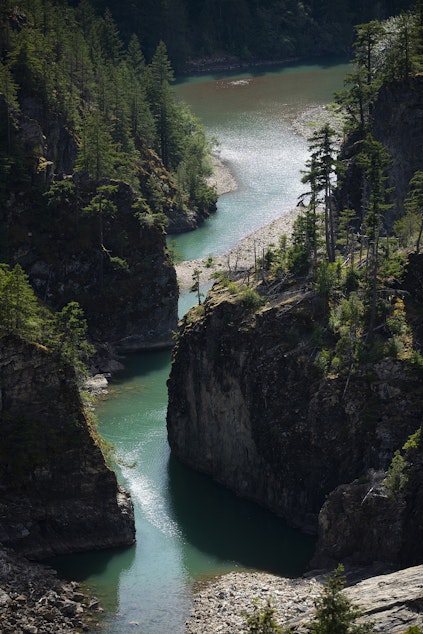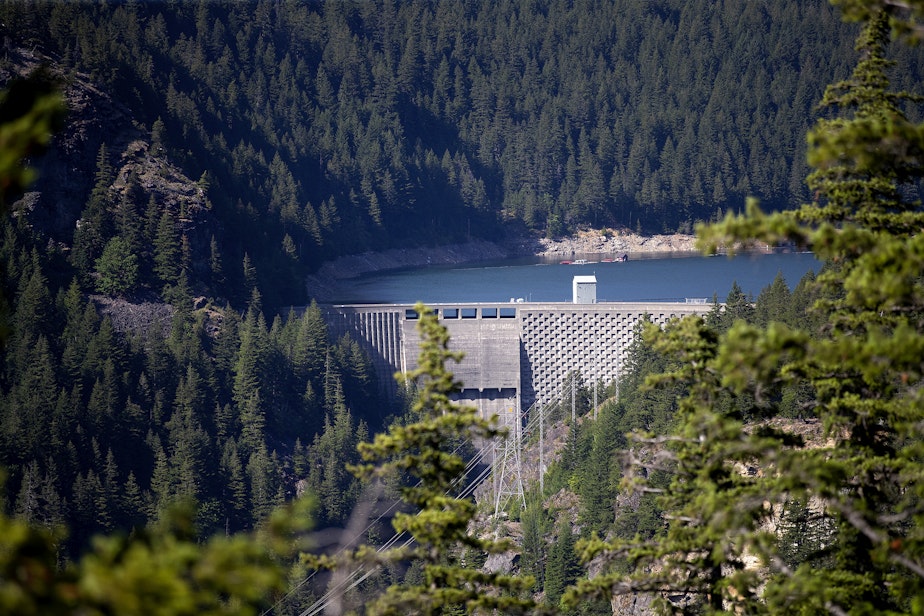Getting fish passage over Skagit dams will take decades
Seattle City Light has a new plan to include fish passage on the Upper Skagit dams. The plan is required as part of the process of getting the dams relicensed by the federal government. This comes after years of conflict with tribes who say the three Skagit dams are getting in the way of the salmon. If successful, the fish passage plan would reintroduce salmon to a habitat they haven't visited for more than 50 years.
S
cott Schuyler is standing by his boat on the banks of the Upper Skagit River working on his fishing net with a relative and getting it ready for a different fishery.
He had been fishing for Chinook salmon.
“We didn't do very good at all. We caught a total of 19. And we were hoping for more, but you know, that's, that's fishing. Sometimes it's okay. And sometimes it's four,” he said.
Typically, the first big purchase a teenager makes is a car, but for Schuyler it was a boat. He's been fishing on this river for more than 30 years. Today he’s still a fisherman, but he’s also a policy representative of the Upper Skagit Indian Tribe.
Sponsored
Alongside other Indigenous leaders in the area, he’s been a significant voice when it comes to advocating for fish and restoring the region's ecosystem to its most undisturbed state. That means removing the dams and bringing back the wetlands where the now declining salmon once flourished and spawned.
Around his fishing spot, this bank is surrounded by picturesque small to mid-sized farms, and lumber yards, but before they were here, Schuyler's ancestors were fishing here for tens of thousands of years.
Schuyler said a large focus for the restoration of fish, like the Chinook, but also sockeye has been habitat restoration in the estuaries where these fish spawn. A lot of those habitats have been affected by the dike systems that the agriculture industry depends heavily on.
“There's been work being done on the Skagit and the lower river and some of the habitat and the mid range on the river during the last license,” Schuyler said. “But you know, the trend still continued to decline. And so it was time to try something new.”
He sees Seattle City Light including plans for a fish passage as a way forward. A spokesperson from the National Oceanic and Atmospheric Administration agreed, saying habitat is the biggest factor limiting salmon recovery, and fish passage past the dams could provide salmon with access to potentially 70 to 100 miles of high-quality habitat.
Sponsored

This additional habitat could be especially beneficial as temperatures are cooler and water is more consistent at higher elevations, something to keep in mind as the climate continues to become warmer and more unstable.
F
arther up the river, Chris Townsend, director of natural resources and hydro licensing for Seattle City Light, was driving a truck up a zigzagging dirt path. There’s still more than a decade of work to do before the fish passage program could be completed.
Sponsored
Part of that is getting a road from the lower Gorge Dam all the way upriver passed Ross Dam. The plan calls for trucking the salmon around some of the dams, but right now that’s not possible.
“It's a one-lane road, and it's very steep," Townsend said between attempts to steer the truck around corners. "It'll have to be made into a two-lane road in order to implement a fish hatchery or a fish passage program."
Sponsored
While building the road, Seattle City Light will be proceed through a more than two-decade-long, three-phase process to create adequate fish passages up the Skagit River.
In phase one, a committee will be formed that’s managed by Seattle City Light, with representatives from the Sauk-Suiattle Tribe, the Swinomish Indian Tribal Community, the Upper Skagit Indian Tribe (which Schuyler is a member of), and an alphabet soup of federal wildlife partners.
They’ll start the work of finding which fish will be included, like potentially the Chinook or king salmon, as well what kind of studies need to be done to understand the impact of fish passage.
In phase two they’ll start the pilot project and gauge the success of their work.
Phase three is where the projects get built, and implemented. The goal is to have the entire project and all its phases completed 20 years from now.
Sponsored
“I don’t think we’re planning on reinventing the wheel; we’re using lessons learned from past efforts to try and build something that’s successful,” said Erin Lowery, a fisheries biologist for Seattle City Light.

At the end, they’ll be introducing a species, maybe even more than just one, of fish that hasn’t been at the top of the dams for the past 50 years. Right now there isn’t a lot of diversity there.
“So, because it's species poor, nature abhors a vacuum, right?” he said. “So you add a novel population into a novel habitat, there's a lot of uncertainty as to how they'll interact with that habitat.”
There's already been an example of a new fish species introduced a couple decades ago. Redside Shiners were introduced into the top of the dam system by what Lowery expects was a bait bucket.
At that time there were two species of trout that existed at Ross before the introduction of the shiners — rainbow trout, which eat zooplankton, and bull trout, which eat other fish.
Sponsored
With the introduction of the shiners, bull trout have been feasting on the shiners and their age and population size increased, and, to Lowery's surprise, the once zooplankton-loving rainbow trout have also been following suit.
"We've created a novel predator in an environment that only had one top predator," Lowery said. "Now we have two top predators exploiting that novel resource out there."
He’s uncertain what will happen when a new fish species or even multiple species are introduced.
Schuyler hopes that uncertainty is resolved the same way other examples of successful fish passage have played out in the region. He says he expects his children and grandchildren will see the results of his work.
"I'm a tribal elder, but I do have kids that are in their 20s and 30s," Schuyler said. "And hopefully, they'll see the fruits of our hard work and the stuff we’re trying to accomplish now."
Seattle City Light still needs to settle a few lawsuits, and then there’s still an environmental impact review that federal licensers need to issue. If those lawsuits are settled and the review is approved, officials expect they will find out whether they’ll get federal approval for the fish passage plan in three to four years. When and if that happens, they’ll begin the decades long task of carving out a path for the fish.
EDITOR'S NOTE: The original version of this story incorrectly said that the committee working on the fish passage plans would be housed in the Skagit County government. That committee work will be managed by Seattle City Light.




